Performance Comparison of Traction Synchronous Motors with Ferrite Magnets for a Subway Train: Reluctance versus Homopolar Variants
Abstract
1. Introduction
1.1. Disadvantages of Induction Motors and Motors with Rare Earth Magnets
- (1)
- (2)
- Continuous torque capability is significantly worse than permanent magnet synchronous motors (PMSM) [4];
- (3)
- Higher inverter power rating with a required constant power speed range (CPSR) over 3:1 [5,6]. For example, a study [5] presents a traction drive based on an IM with a mechanical power of 50 kW and a CPSR of 3.5:1, and the power rating of the traction inverter is 125 kVA. Study [6] presents a traction drive based on an IM with a mechanical power of 50 kW and a CPSR of 4:1, and the power rating of the traction inverter is 125 kVA.
- (1)
- (2)
- In the near future, a shortage of materials for the production of rare earth magnets is predicted due to the rapid growth in the production of electric vehicles and wind turbines, which very often use rare earth permanent magnets [11];
- (3)
- Rare-earth element extraction has an adverse environmental impact [12];
- (4)
- The demagnetization of rare-earth magnets can occur in high-power density PMSMs due to the presence of strong magnetic fields and high temperatures;
- (5)
- The task of maintaining high efficiency at speeds near the maximum becomes challenging when aiming for a wide constant power speed range, primarily due to increased copper loss that occurs in the field weakening mode [13];
- (6)
- Furthermore, in electrical power applications such as subway and railway trains, the rotational motion of PMSM induces a significant uncontrolled electromotive force (EMF) in the winding. This situation presents a significant risk of fire in the event of an emergency short circuit. Given the high inertia of the trains, which makes them unable to stop in time in such critical situations, it is recommended to refrain from using the PMSM in this application.
1.2. Literature Overview on the Use of Ferrite-Assisted Synchronous Reluctance Motors in Traction Drives
1.3. Literature Overview on the Use of Synchronous Homopolar Motors in Traction Drives and on the Use of Ferrite-Assisted Synchronous Homopolar Motors
1.4. The Problem and Aim of the Study
2. Representation of the Train Flow Pattern in the Motor Optimization Routine
3. Designs Features of the FaSHM and FaSynRM
4. Objectives and Parameters of the Optimization
- (1)
- Minimizing the average electrical losses, denoted as <Ploss el>, which is calculated as a weighted average of losses at different operating points;
- (2)
- Minimizing the maximum armature winding current, indicated by max(Iarm i), across operating points 1–5;
- (3)
- Minimizing the maximum torque ripple, indicated by max (TRi), across operating points 1–5;
- (4)
- Reducing to zero δdemag, which represents the cross-section area of magnets exposed to a demagnetization magnetic field stronger than the marginal demagnetization field H0, relative to the overall cross-section area of the magnets.
5. FaSHM Optimization Parameters and Results
5.1. FaSHM Optimization Parameters
5.2. FaSHM Optimization Results
- (1)
- The maximum current decreased slightly by 100%(541 − 539)/541 = 0.4%;
- (2)
- The main advantage of the new FaSHM design is a significantly increased resistance to demagnetization of magnets. The coercive force of the Y30H-2 magnet is about 4 kOe [35]. In the design optimized in [14], the maximum demagnetizing field is 3 kOe, and the margin is (4 − 3) = 1 kOe. In the new design, the maximum demagnetizing field is 2.5 kOe, and the margin is 1.5. Therefore, we can conclude that the new design is one and a half times more reliable for demagnetization of magnets. This is due to an increase in the width of the magnet (equal to the depth of the rotor slot) from 7.5 cm to 8.3 cm [14]. In addition, the lengths of the stator and rotor lamination have increased, which redistributed the flux over a larger area. Reducing the cross-sections of the housing and sleeve led to an increase in flux density;
- (3)
- Core losses during coasting have been reduced by 100%(705 − 639)/705 = 9.4%, which contributes to the reduction of the average losses;
- (4)
- However, due to achieving better reliability with respect to demagnetization, the average losses slightly increased by 100%(7.16 − 7.05)/7.16 = 1.5%.
6. FaSynRM Optimization Parameters and Results
6.1. FaSynRM Optimization Parameters
y1i = yi∙c, i = 1, 2, 3;
yi = y1i∙g, i = 1, 2, 3, 4;
hcut i = acut i + bcut i(i − 1), i = 1, 2, 3, 4;
hst i = ast i + bst i(i − 1), i = 1, 2, 3, 4.
6.2. FaSynRM Optimization Results
- (1)
- Average losses were reduced by 100%(10.46 − 7.4)/10.46 = 29.3%;
- (2)
- Maximum armature winding current decreased by 100%(1402 − 839)/1402 = 40%;
- (3)
- Maximum torque ripple decreased by (33 − 10) = 23%;
- (4)
- The share of magnets δdemag exposed to a demagnetizing field of more than 2 kOe decreased from 8.6% to almost zero (0.06%). As can be seen from Figure 15, the −2 kOe level is reached only in the corners of the magnets, and it can be concluded that the demagnetization of this small share of magnets is not critical. Therefore, we can conclude that with a coercive force of 4 kOe, the optimized design has a large safety margin (4 − 2) = 2 kOe. The achievement of a higher resistance to demagnetization of the design after optimization, apparently, was facilitated by an increase in the thickness of the magnets, as well as an increase in the number of turns, and hence a decrease in the turn voltage and magnetic flux in the magnetic circuits.
7. Comparison of Characteristics of FaSHM and FaSynRM
- (1)
- In this application, the average loss of the FaSHM is 100%(7.4 − 7.16)/7.4 = 3.4% less than that of FaSynRM;
- (2)
- By adjusting the excitation flux, the maximum armature current for the FaSHM is 833/539 = 1.54 times less than for the FaSynRM, which potentially makes it possible to significantly reduce the cost of power modules of the traction inverter;
- (3)
- The active volume of magnetic cores, excluding the stator housing, in the FaSynRM is 100%(47.1 − 45.4)/47.1 = 3.9% higher than in the FaSHM;
- (4)
- The length of the FaSHM stator laminations is less than that of FaSynRM by 100%(240 − 227)/240 = 5.4%; the length of the FaSHM, taking into account the gap for installing the excitation winding, is greater by 100%(260 − 240)/260 = 7.7%;
- (5)
- The mass of active materials of the FaSHM is greater than that of the FaSynRM by 100%(359.2 − 98.9 − 241)/(359.2 − 98.9) = 7.4% excluding the housing and sleeve;
- (6)
- The cost of the FaSHM active materials is 100%(1152.7 − 818.2)/818.2 = 29.0% higher than that of the FaSynRM (excluding the housing and sleeve) due to the greater mass of copper and magnets;
- (7)
- The maximum modulus of the demagnetizing force in the case of the FaSHM is greater than in the case of the FaSynRM by (2.5 − 2) = 0.5 kOe. In this case, the demagnetization margin for the FaSynRM is (4 − 2) = 2 kOe, and for the FaSHM is (4 − 2.5) = 1.5 kOe, where 4 kOe is the coercive force of ferrite magnets. Therefore, the FaSHM requires a more careful design of control algorithms to avoid demagnetization during failures and transients.
8. Conclusions
Author Contributions
Funding
Institutional Review Board Statement
Informed Consent Statement
Data Availability Statement
Acknowledgments
Conflicts of Interest
References
- Matsuoka, K.; Kondo, M. Energy Saving Technologies for Railway Traction Motors. IEEJ Trans. Electr. Electron. Eng. 2010, 5, 278–284. [Google Scholar] [CrossRef]
- De Almeida, A.T.; Ferreira, F.J.; Baoming, G. Beyond Induction Motors—Technology Trends to Move up Efficiency. IEEE Trans. Ind. Appl. 2014, 50, 2103–2114. [Google Scholar] [CrossRef]
- Fedoseyev, L.; Pearce, E.M., Jr. Rotor Assembly with Heat Pipe Cooling System. U.S. Patent US9331552B2, 3 May 2016. Available online: https://patents.google.com/patent/US9331552B2/en?oq=US9331552B2 (accessed on 13 August 2023).
- Guan, Y.; Zhu, Z.Q.; Afinowi, I.A.A.; Mipo, J.C.; Farah, P. Comparison between induction machine and interior permanent magnet machine for electric vehicle application. In Proceedings of the 2014 17th International Conference on Electrical Machines and Systems (ICEMS), Hangzhou, China, 22–25 October 2014; pp. 144–150. [Google Scholar]
- Kim, B.; Lee, J.; Jeong, Y.; Kang, B.; Kim, K.; Kim, Y.; Park, Y. Development of 50 kW traction induction motor for electric vehicle (EV). In Proceedings of the 2012 IEEE Vehicle Power and Propulsion Conference, Seoul, Republic of Korea, 9–12 October 2012; pp. 142–147. [Google Scholar]
- Zhu, Z.Q.; Chu, W.Q.; Guan, Y. Quantitative comparison of electromagnetic performance of electrical machines for HEVs/EVs. CES Trans. Electr. Mach. Syst. 2017, 1, 37–47. [Google Scholar] [CrossRef]
- Dianov, A. Instant Closing of Permanent Magnet Synchronous Motor Control Systems at Open-Loop Start. Sustainability 2022, 14, 12665. [Google Scholar] [CrossRef]
- Schulze, R. Reducing Environmental Impacts of the Global Rare Earth Production for Use in Nd-Fe-B Magnets. How Much Can Recycling Contribute? Ph.D. Thesis, Technical University of Darmstadt, Darmstadt, Germany, December 2018. Available online: https://tuprints.ulb.tu-darmstadt.de/8301/7/Diss%20Rita%20Schulze%2015-12-2018.pdf (accessed on 13 August 2023).
- Dong, S.; Li, W.; Chen, H.; Han, R. The status of Chinese permanent magnet industry and R&D activities. AIP Adv. 2017, 7, 056237. [Google Scholar] [CrossRef]
- Carraro, E.; Bianchi, N.; Zhang, S.; Koch, M. Design and Performance Comparison of Fractional Slot Concentrated Winding Spoke Type Synchronous Motors with Different Slot-Pole Combinations. IEEE Trans. Ind. Appl. 2018, 54, 2276–2284. [Google Scholar] [CrossRef]
- The Net-Zero Materials Transition: Implications for Global Supply Chains, Report, McKinsey & Company, July 2023. Available online: https://www.mckinsey.com/industries/metals-and-mining/our-insights/the-net-zero-materials-transition-implications-for-global-supply-chains (accessed on 13 August 2023).
- De Lima, W.I.B. Rare Earth Industry; Elsevier: Amsterdam, The Netherlands, 2015. [Google Scholar]
- Papini, F.; Osama, M. Electromagnetic Design of an Interior Permanent Magnet Motor for Vehicle Traction. In Proceedings of the 2018 XIII International Conference on Electrical Machines (ICEM), Alexandroupoli, Greece, 3–6 September 2018; pp. 205–211. [Google Scholar] [CrossRef]
- Dmitrievskii, V.; Prakht, V.; Kazakbaev, V. Design Optimization of a Synchronous Homopolar Motor with Ferrite Magnets for Subway Train. Mathematics 2023, 11, 589. [Google Scholar] [CrossRef]
- Dobzhanskyi, O.; Grebenikov, V.; Gouws, R.; Gamaliia, R.; Hossain, E. Comparative Thermal and Demagnetization Analysis of the PM Machines with Neodymium and Ferrite Magnets. Energies 2022, 15, 4484. [Google Scholar] [CrossRef]
- Manne, B.; Kiran Kumar, M.; B. Akuru, U. Design and Performance Assessment of a Small-Scale Ferrite-PM Flux Reversal Wind Generator. Energies 2020, 13, 5565. [Google Scholar] [CrossRef]
- Ibrahim, M.N.; Silwal, B.; Sergeant, P. Permanent Magnet-Assisted Synchronous Reluctance Motor Employing a Hybrid Star-Delta Winding for High Speed Applications. In Proceedings of the 2018 XIII International Conference on Electrical Machines (ICEM), Alexandroupoli, Greece, 3–6 September 2018; pp. 379–385. [Google Scholar]
- Liu, Z.; Hu, Y.; Wu, J.; Zhang, B.; Feng, G. A Novel Modular Permanent Magnet-Assisted Synchronous Reluctance Motor. IEEE Access 2021, 9, 19947–19959. [Google Scholar] [CrossRef]
- Barcaro, M.; Pradella, T.; Furlan, I. Low-torque ripple design of a ferrite-assisted synchronous reluctance motor. IET Electr. Power Appl. 2016, 10, 319–329. [Google Scholar] [CrossRef]
- Du, G.; Zhang, G.; Li, H.; Hu, C. Comprehensive Comparative Study on Permanent-Magnet-Assisted Synchronous Reluctance Motors and Other Types of Motor. Appl. Sci. 2023, 13, 8557. [Google Scholar] [CrossRef]
- Liu, X.; Li, Y.; Liu, Z.; Ling, T.; Luo, Z. Analysis and design of a high power density permanent magnet-assisted synchronous reluctance machine with low-cost ferrite magnets for EVs/HEVs. COMPEL-Int. J. Comput. Math. Electr. Electron. Eng. 2016, 35, 1949–1964. [Google Scholar] [CrossRef]
- Li, Y.; Yang, H.; Lin, H.; Fang, S.; Wang, W. A Novel Magnet-Axis-Shifted Hybrid Permanent Magnet Machine for Electric Vehicle Applications. Energies 2019, 12, 641. [Google Scholar] [CrossRef]
- Prakht, V.; Dmitrievskii, V.; Kazakbaev, V.; Anuchin, A. Comparative Study of Electrically Excited Conventional and Homopolar Synchronous Motors for the Traction Drive of a Mining Dump Truck Operating in a Wide Speed Range in Field-Weakening Region. Mathematics 2022, 10, 3364. [Google Scholar] [CrossRef]
- Ren, Z.; Yu, K.; Xin, Q.; Pan, Y. Performance of Homopolar Inductor Alternator with Diode-Bridge Rectifier and Capacitive Load. IEEE Trans. Ind. Electron. 2013, 60, 4891–4902. [Google Scholar] [CrossRef]
- Lorilla, L.; Keim, T.; Lang, J.; Perreault, D. Topologies for future automotive generators. Part I. Modeling and analytics. In Proceedings of the 2005 IEEE Vehicle Power and Propulsion Conference, Chicago, IL, USA, 7 September 2005; pp. 74–85. [Google Scholar] [CrossRef]
- Orlova, S.; Pugachov, V.; Levin, N. Hybrid Excitation of the Axial Inductor Machine. Latv. J. Phys. Tech. Sci. 2012, 49, 35–41. [Google Scholar] [CrossRef][Green Version]
- Dmitrievskii, V.; Prakht, V.; Anuchin, A.; Kazakbaev, V. Traction Synchronous Homopolar Motor: Simplified Computation Technique and Experimental Validation. IEEE Access 2020, 8, 185112–185120. [Google Scholar] [CrossRef]
- Bekhaled, C.; Hlioui, S.; Vido, L.; Gabsi, M.; Lecrivain, M.; Amara, Y. 3D magnetic equivalent circuit model for homopolar hybrid excitation synchronous machines. In Proceedings of the 2007 International Aegean Conference on Electrical Machines and Power Electronics, Bodrum, Turkey, 10–12 September 2007; pp. 575–580. [Google Scholar] [CrossRef]
- Asfirane, S.; Hlioui, S.; Amara, Y.; Gabsi, M. Study of a Hybrid Excitation Synchronous Machine: Modeling and Experimental Validation. Math. Comput. Appl. 2019, 24, 34. [Google Scholar] [CrossRef]
- Hoang, E.; Lecrivain, M.; Hlioui, S.; Gabsi, M. Hybrid excitation synchronous permanent magnets synchronous machines optimally designed for hybrid and full electrical vehicle. In Proceedings of the 8th International Conference on Power Electronics—ECCE Asia, Seogwipo, Republic of Korea, 30 May–3 June 2011. [Google Scholar] [CrossRef]
- Gandzha, S.; Chuyduk, I.; Nazarov, M. Development of a Motor-Wheel Based on a Brushless Machine of Combined Excitation for Hybrid and Electric Transport. In Proceedings of the 2021 International Ural Conference on Electrical Power Engineering (UralCon), Magnitogorsk, Russia, 24–26 September 2021; pp. 630–633. [Google Scholar]
- IEC. Specifications for Particular Types of Winding Wires—Part 0–2: General Requirements—Enamelled Rectangular Copper Wire; IEC 60317-0-2:2020; IEC: Geneva, Switzerland, 2020; Available online: https://webstore.iec.ch/publication/63495 (accessed on 13 August 2023).
- Lagarias, J.C.; Reeds, J.A.; Wright, M.H.; Wright, P.E. Convergence properties of the Nelder–Mead simplex method in low dimensions. SIAM J. Optim. 1998, 9, 112–147. [Google Scholar] [CrossRef]
- Find Minimum of Unconstrained Multivariable Function Using Derivative-Free Method. MATLAB Documentation. © 1994–2023 The MathWorks, Inc. Available online: https://www.mathworks.com/help/matlab/ref/fminsearch.html (accessed on 30 August 2023).
- Grades of Ferrite. The Original Online Company. Bunting. E-Magnets. Available online: https://e-magnetsuk.com/ferrite-magnets/grades-of-ferrite/ (accessed on 13 August 2023).
- Hard Ferrite Magnets, Product Information, IBSMagnet. 2020. Available online: https://ibsmagnet.com/products/dauermagnete/hartferrit.php (accessed on 13 August 2023).
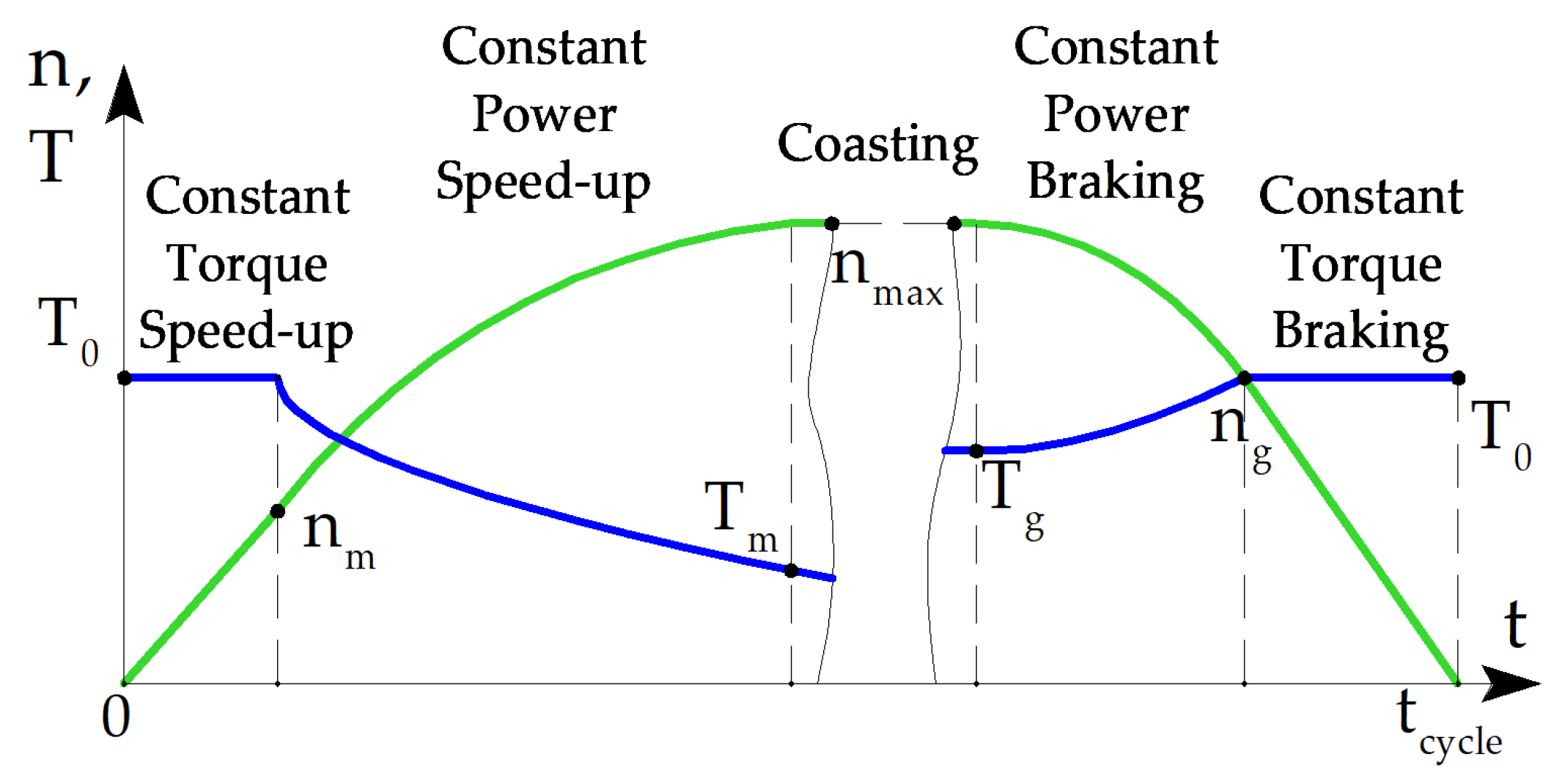
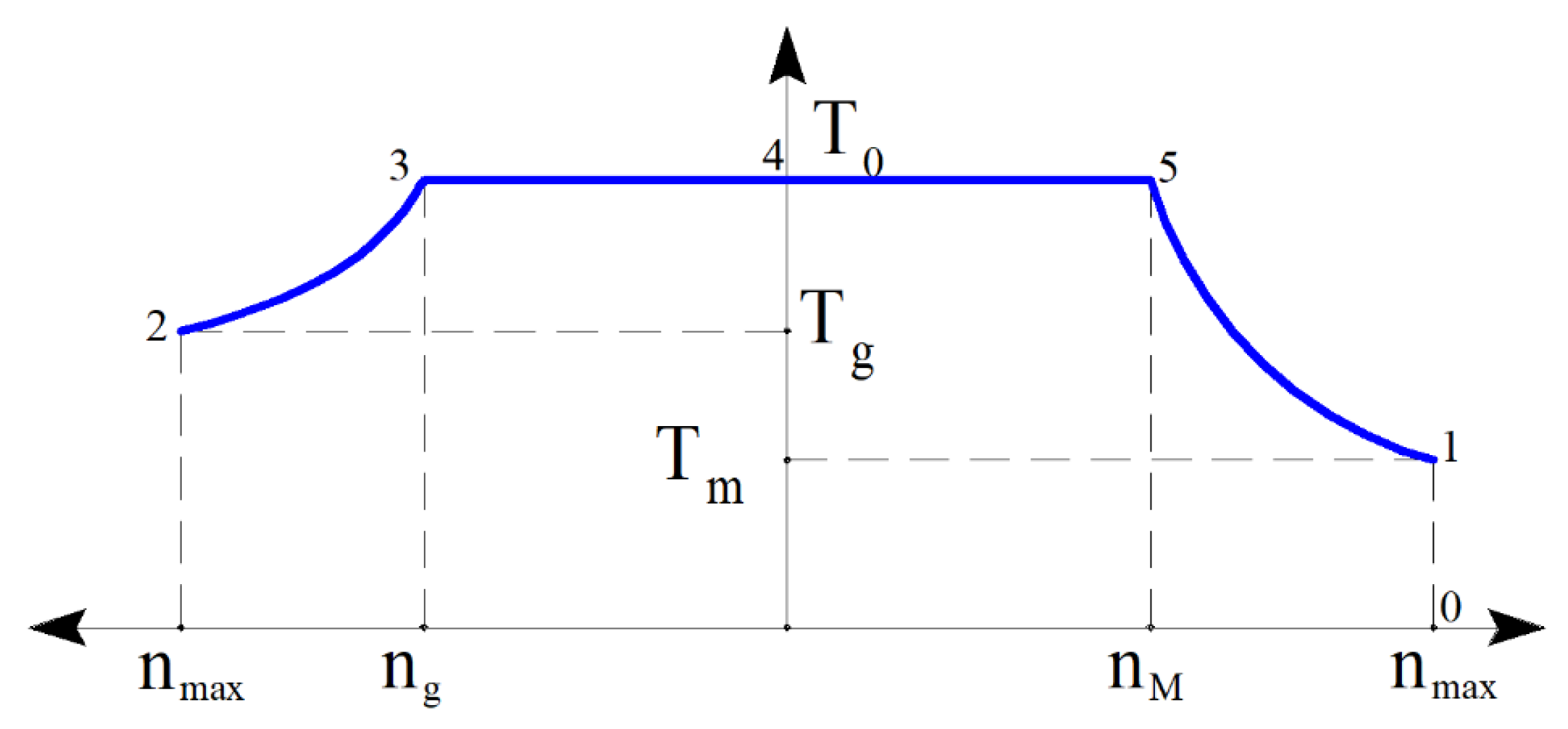
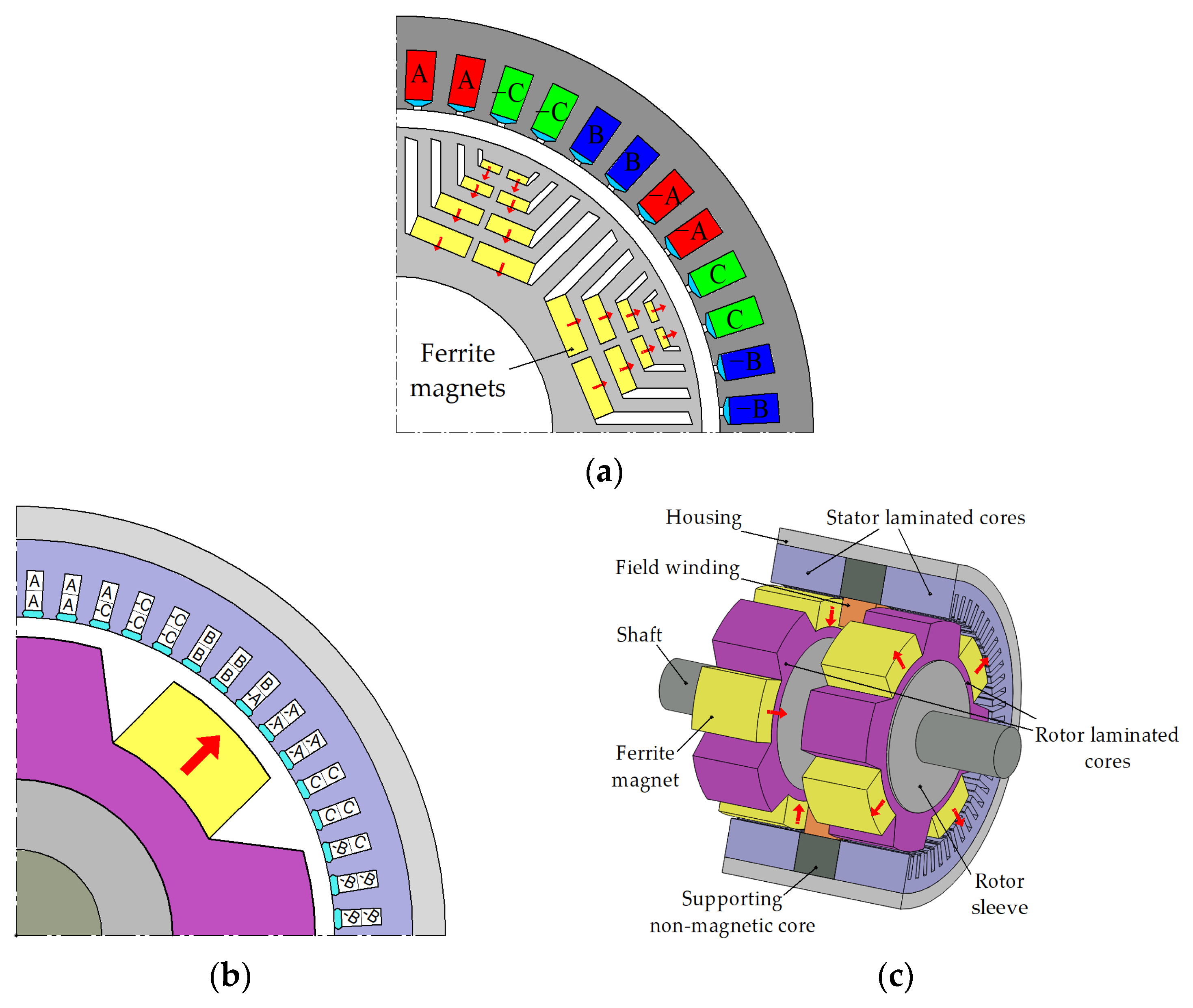
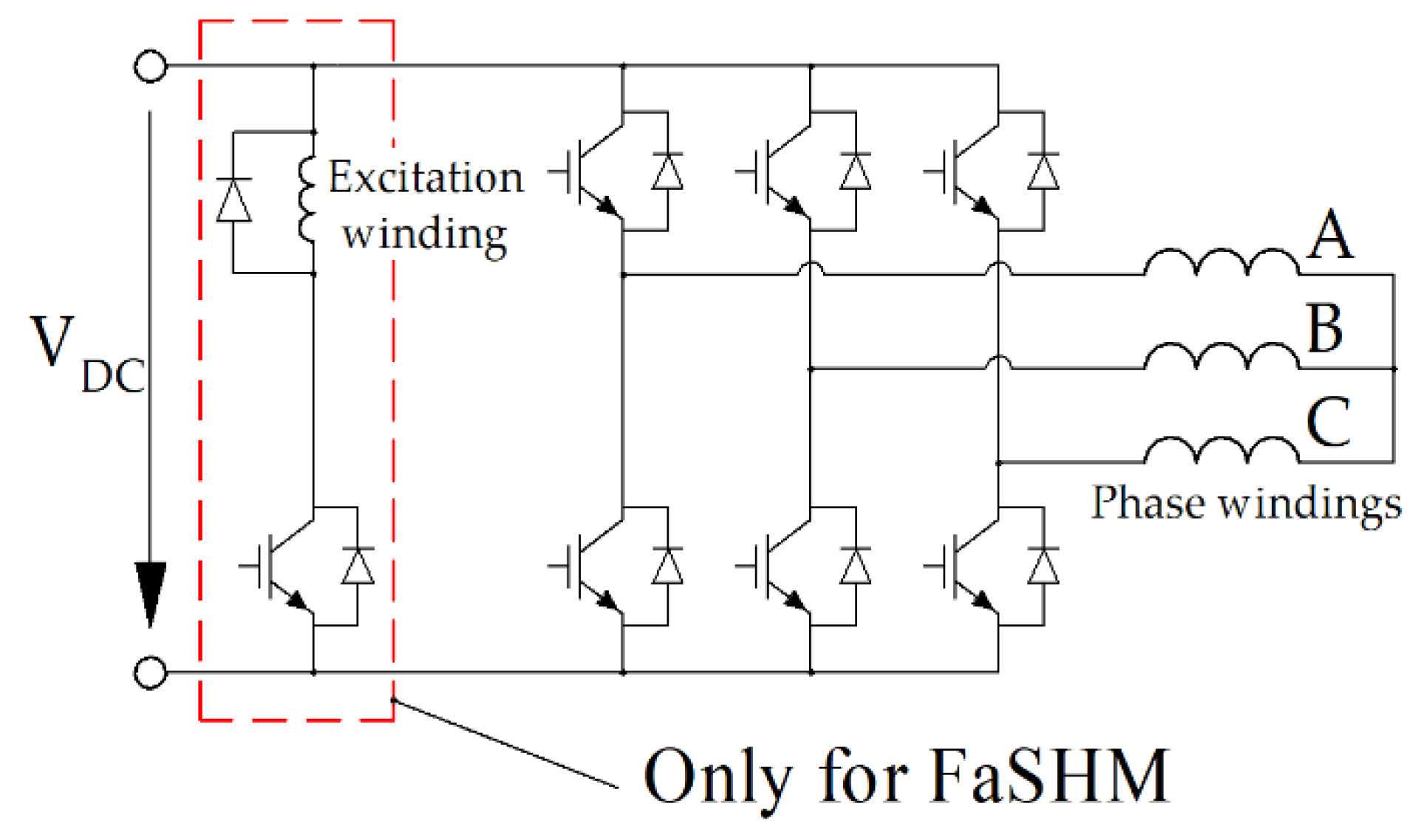

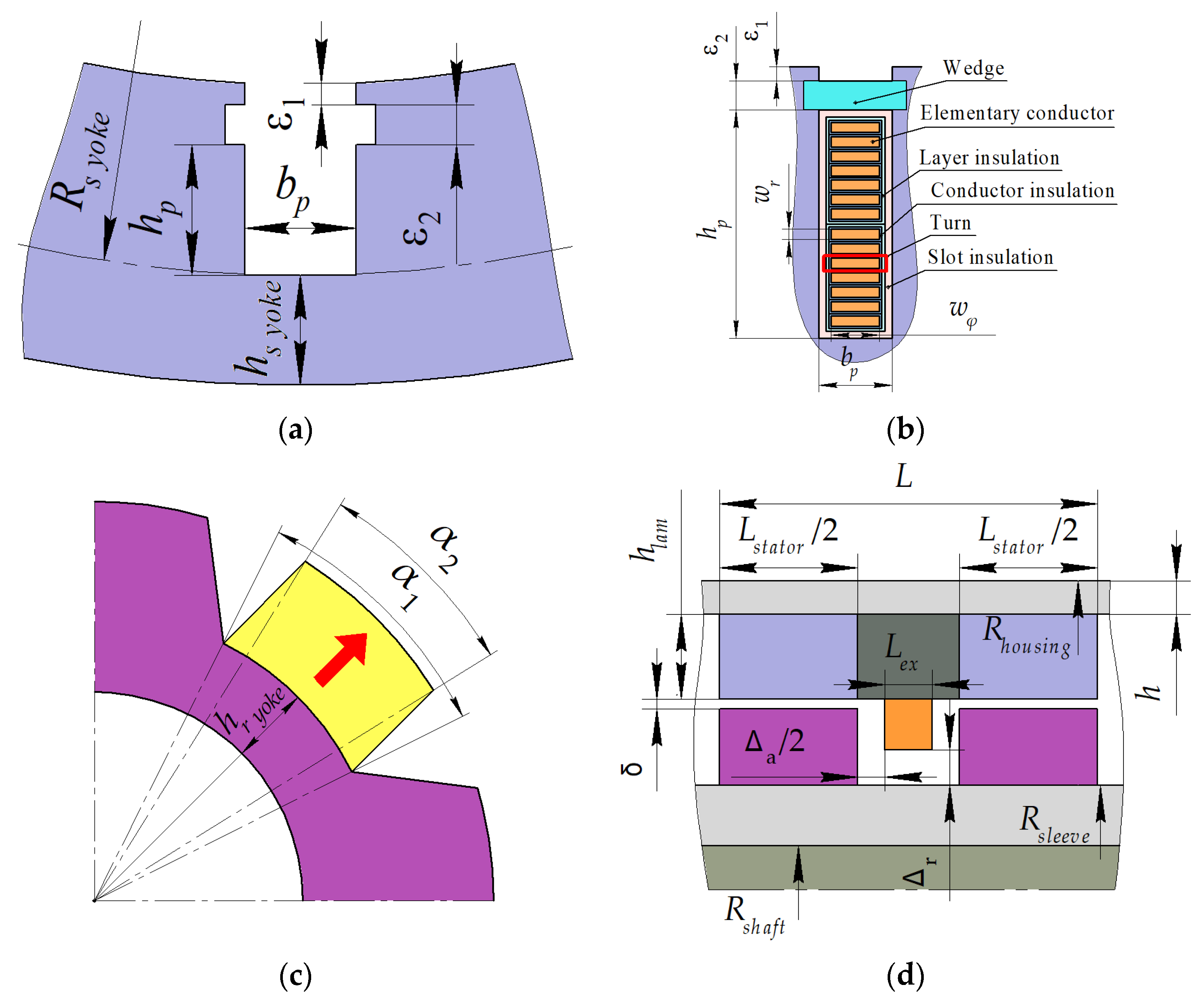



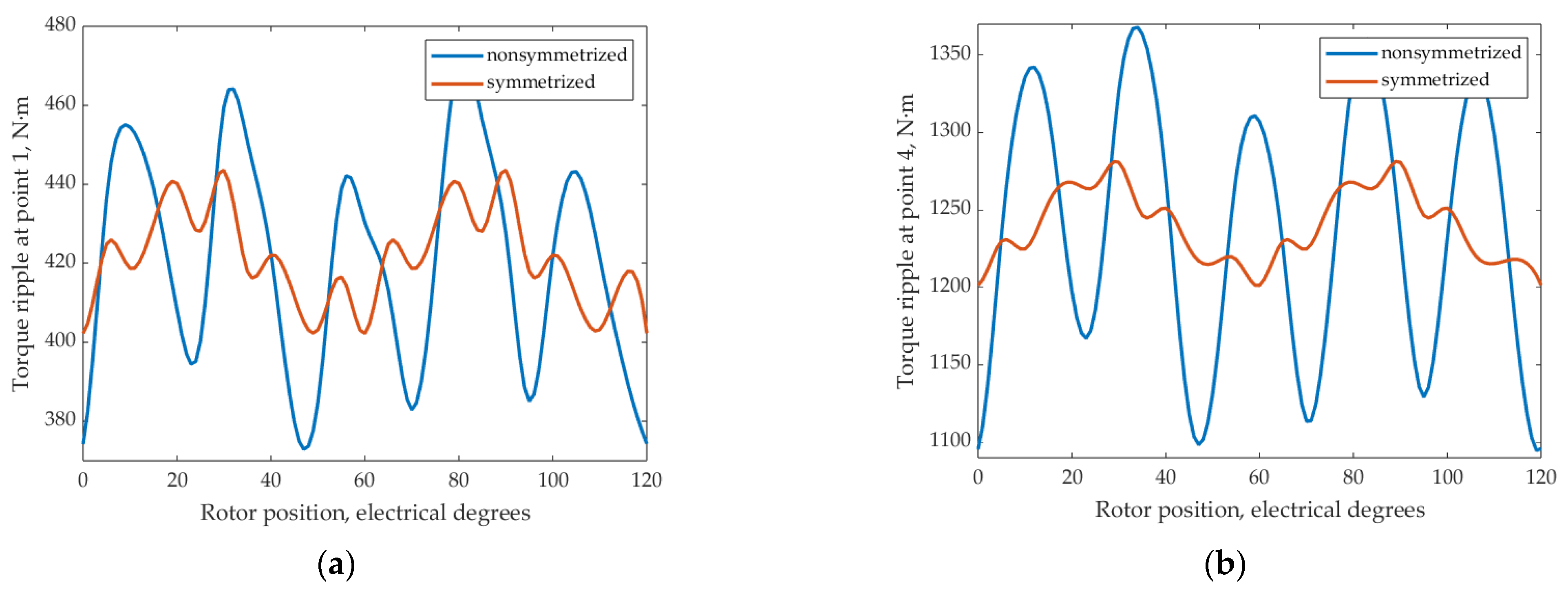
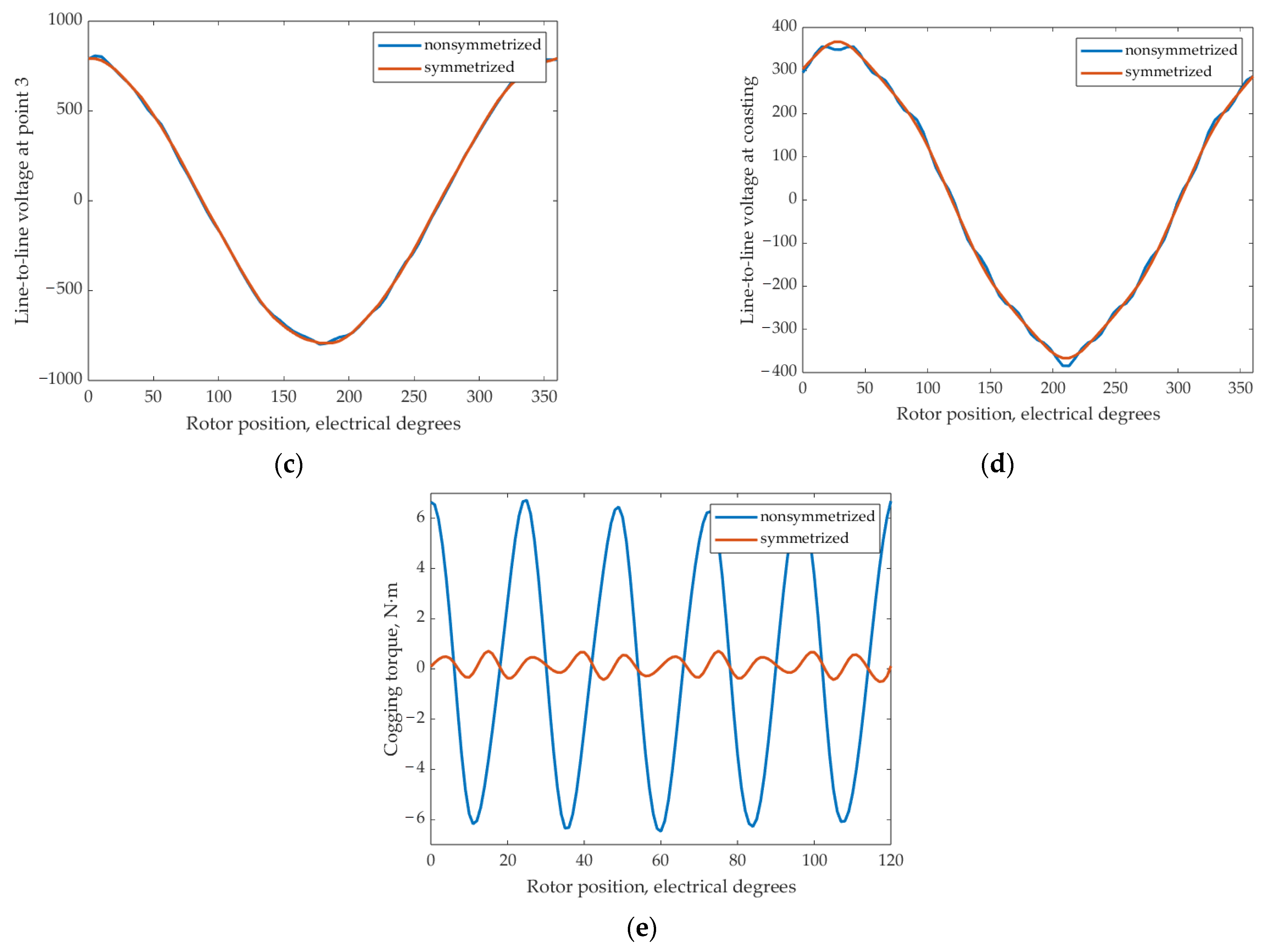
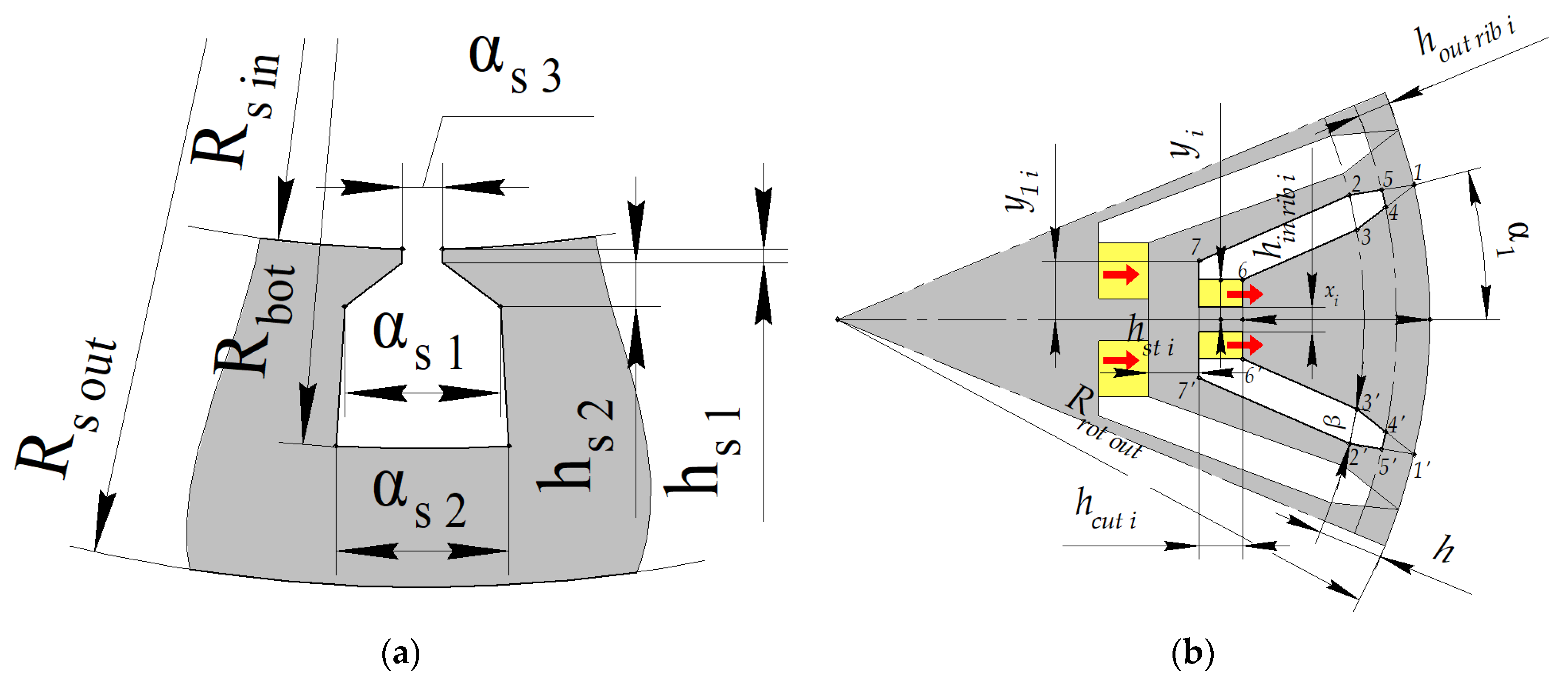

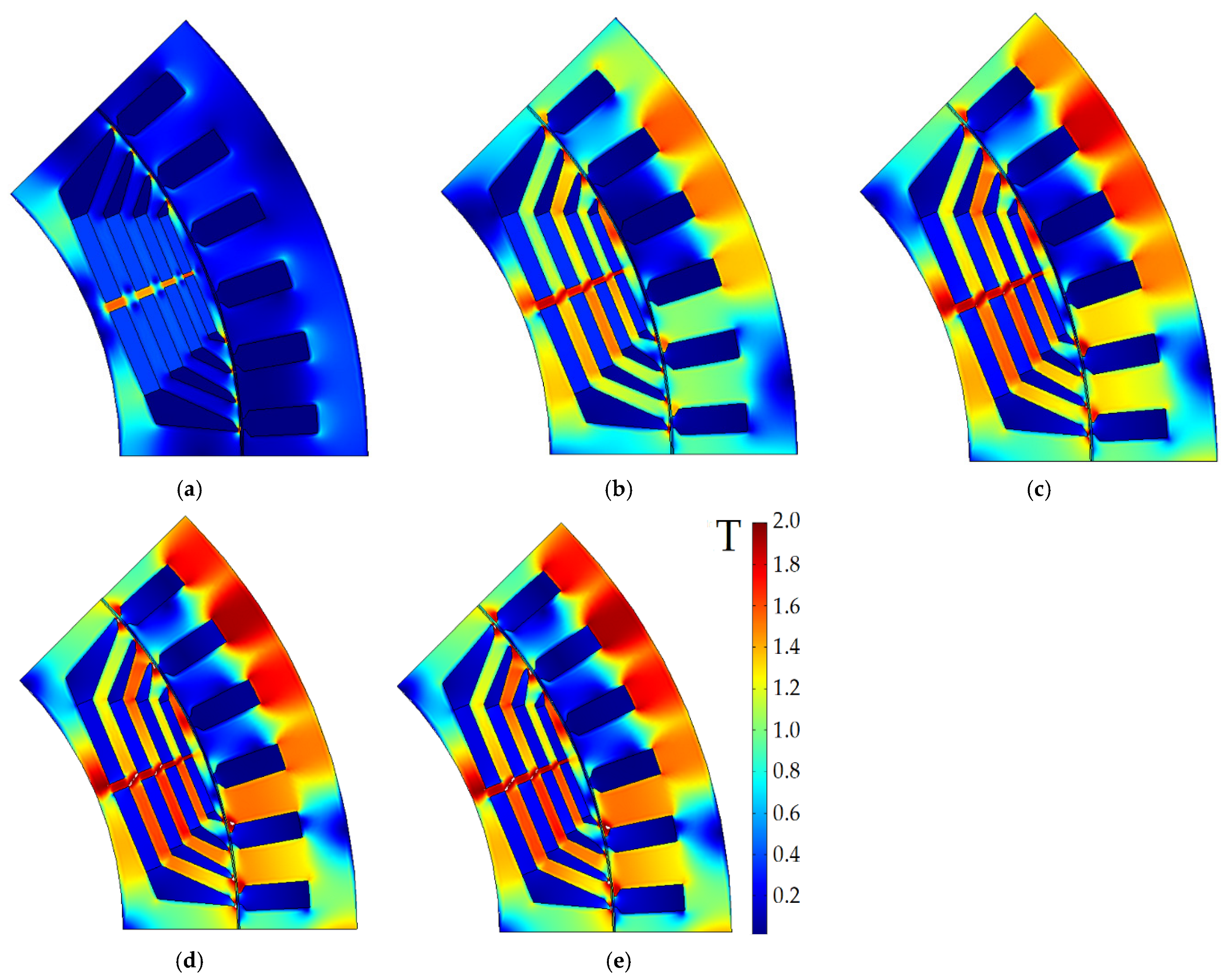

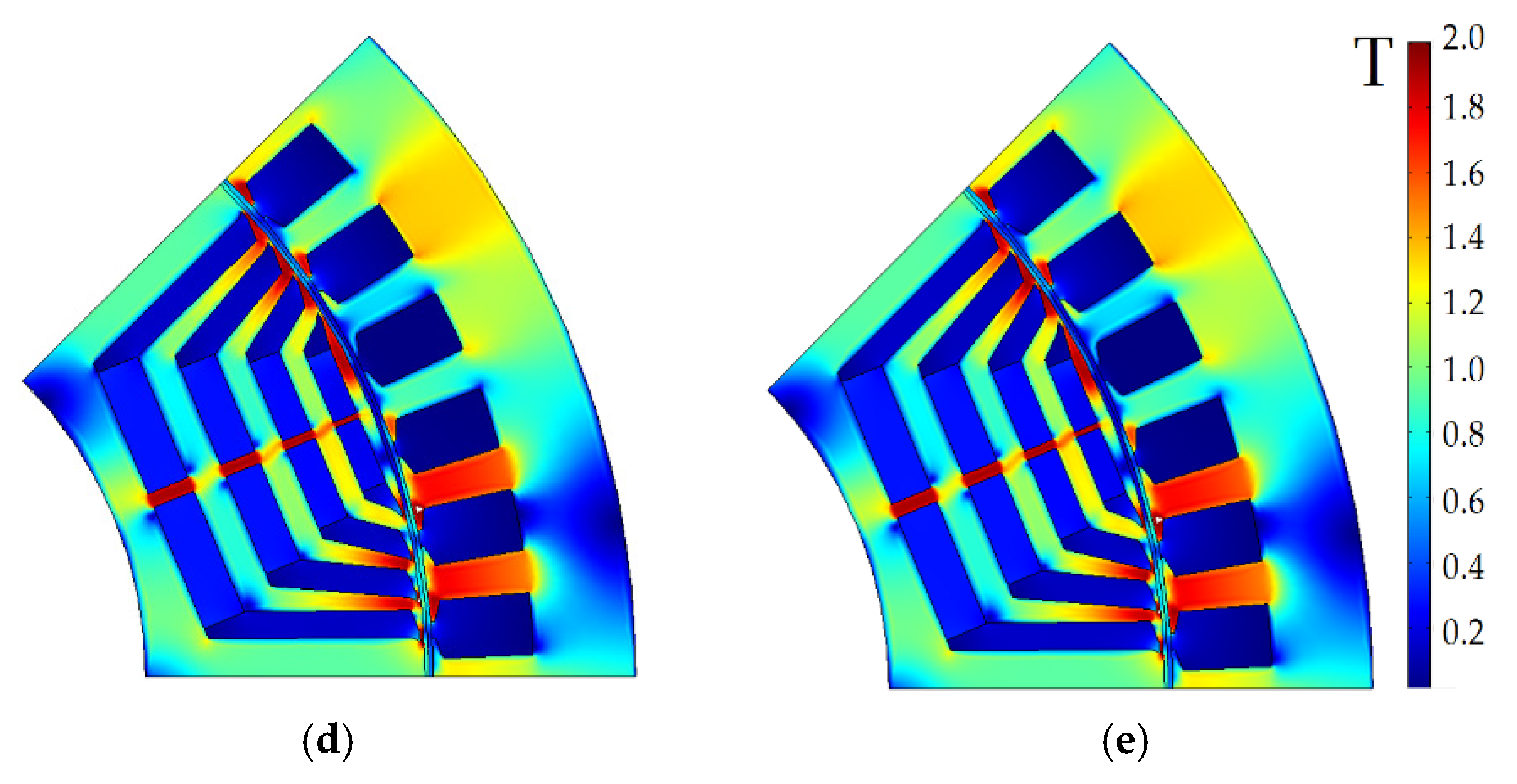
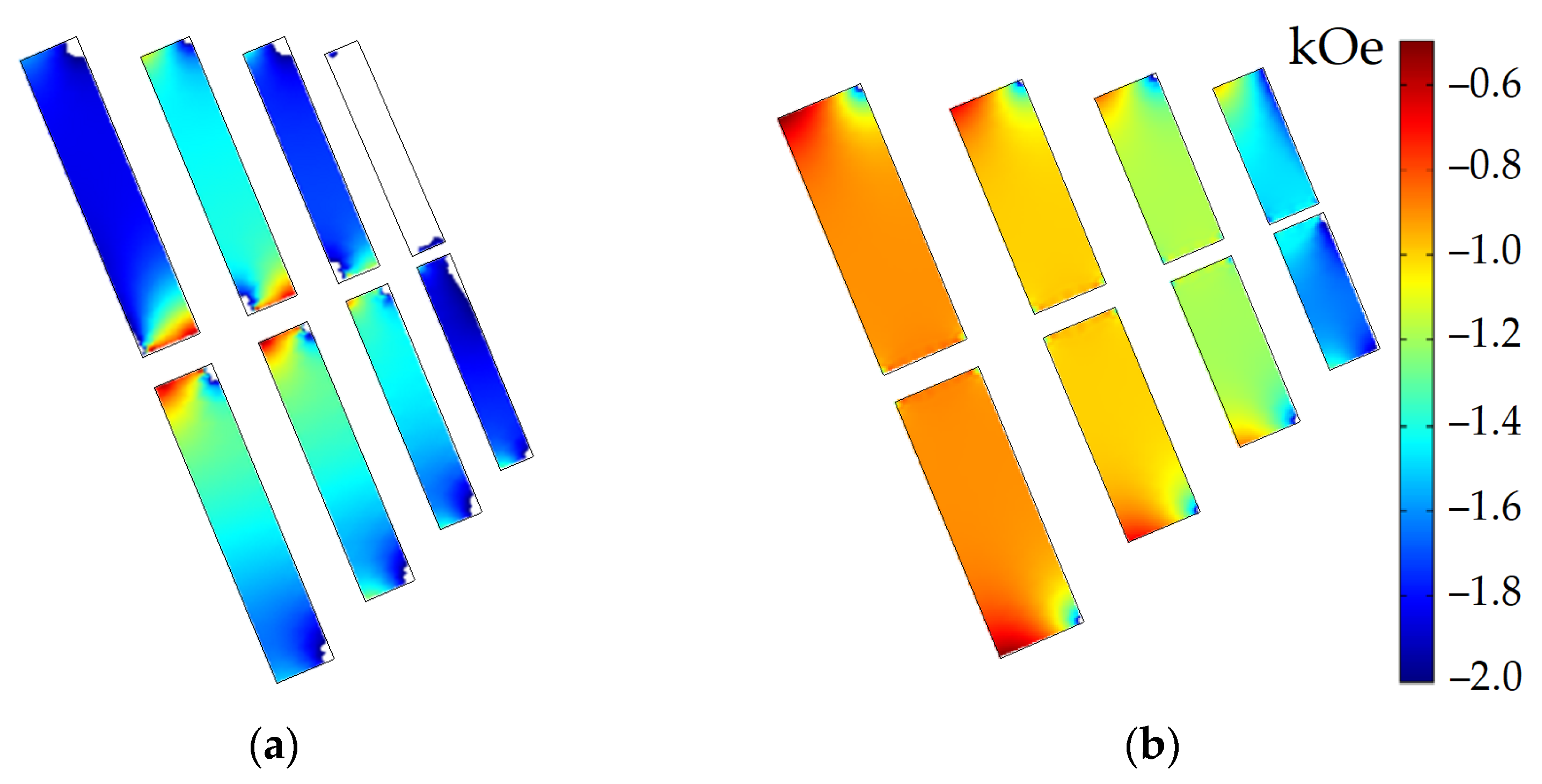
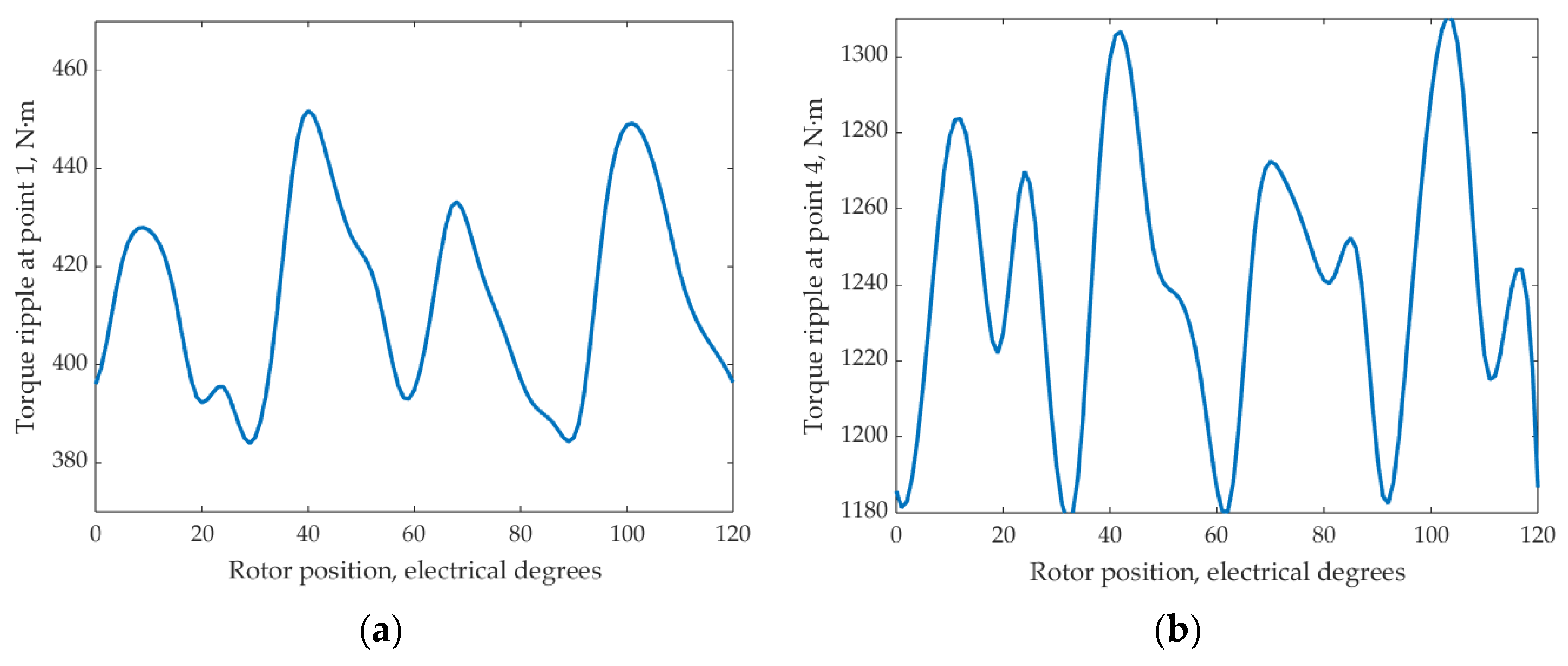
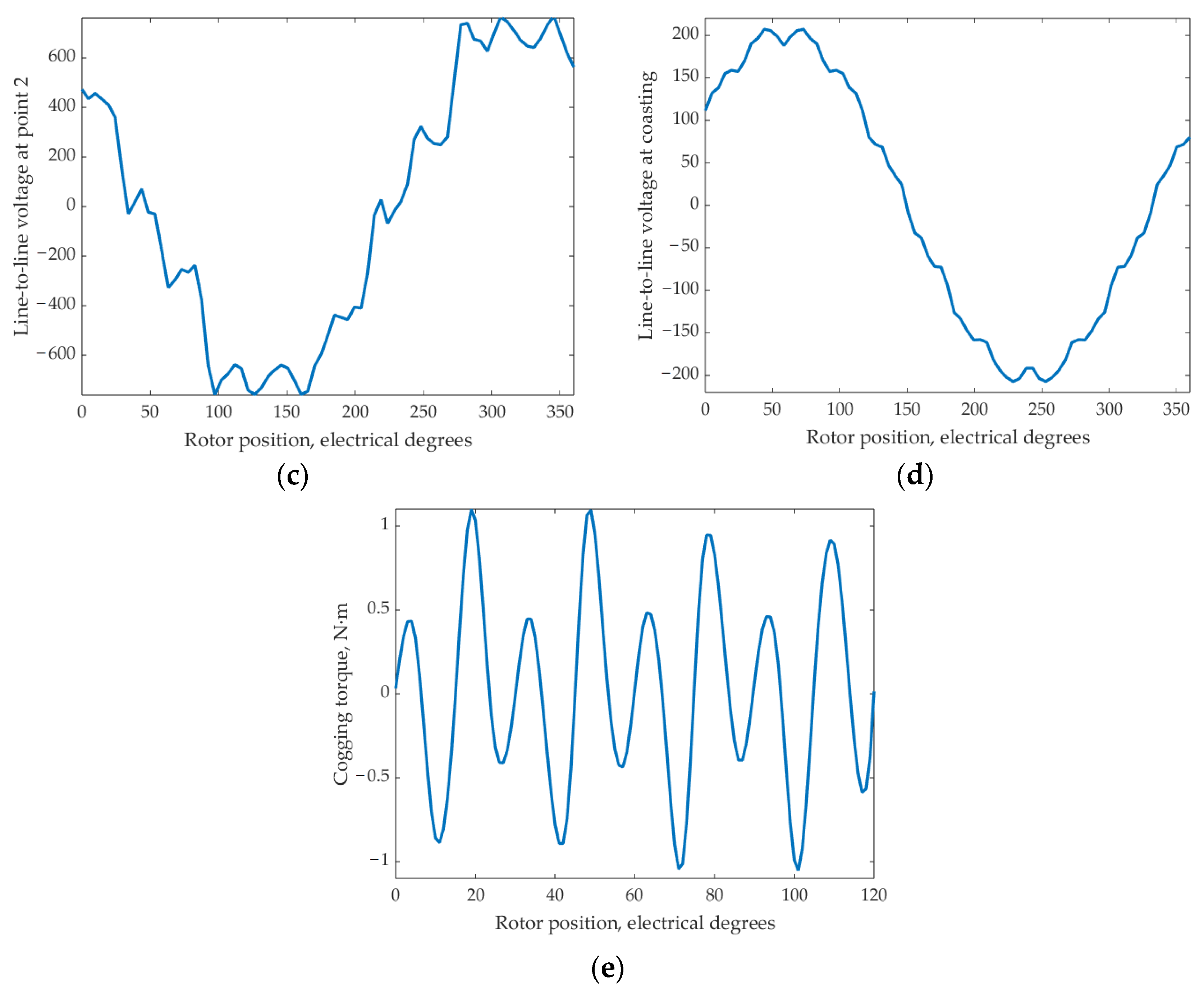
| Operating Point, i | Operating Point Name | Speed ni, rpm | Torque, Ti, N∙m | wi | ki | wexi |
|---|---|---|---|---|---|---|
| 0 | Coasting mode; maximum speed | 4280 | 0 | - | - | 0.5 |
| 1 | Driving mode; maximum speed | 4280 | 413.4 | 0.363 | 0.97 | 0.181 |
| 2 | Braking mode; maximum speed | 4280 | 826.9 | 0.091 | 1.01 | 0.046 |
| 3 | Braking mode; changing from constant power to constant torque operation | 2854 | 1240 | 0.182 | 1.1 | 0.091 |
| 4 | Zero speed | 0 | 1240 | 0.182 | 0.97 | 0.091 |
| 5 | Driving mode; changing from maximum torque to constant power operation modes | 1427 | 1240 | 0.182 | 0.97 | 0.091 |
| Parameter | FaSHM | FaSynRM |
|---|---|---|
| Phase number | 3 | |
| Pole number | 8 | |
| Ferrite magnet grade | Y30H-2 | |
| Excitation winding | Yes | No |
| Number of sets of stator and rotor stacks | 2 | 1 |
| Stator slot number | 60 | 48 |
| Number of the armature winding layers | 2 | 1 |
| Number of the stator slots per pole and phase q | 2.5 | 2 |
| Rotor slot number | 4 | - |
| Rotor flux barrier number per pole | - | 4 |
| Parameter | Before Optimization | After Optimization |
|---|---|---|
| Housing thickness h, mm | 15.6 | 14.8 |
| Total stator stacks length Lstator, mm | 219.6 | 227 |
| Stator slot depth, hp, mm | 35.9 | 31.0 |
| Stator slot width, bp, mm | 9.0 | 7.63 |
| Air gap width δ, mm | 4.4 | 2.98 |
| Rotor slot thickness, α1 | 0.423∙tz * | 0.547∙tz * |
| Rotor slot thickness, α2 | 0.664∙tz * | 0.706∙tz * |
| Current angles at operating points 1,2,3,4, electrical radians | 0.943; 0.921; 0.404; 0.118 | 0.726; 0.834; 0.304; 0.0772 |
| Current ratio ** | 10.55 | 9.77 |
| Parameter | Initial Design | Optimized Design |
|---|---|---|
| Inner stator radius Rstat, m | 0.2 | 0.1943 |
| Stator slot bottom radius Rbot,m | 0.23 | 0.2218 |
| Stator slot thickness αstat1 | 0.4∙tz1 | 0.622∙tz1 |
| Air gap, mm | 1 | 2.23 |
| ast i, mm | 4 | 6.35 |
| bst i, mm | 1 | 1.59 |
| acut i, mm | 4 | 6.95 |
| bcut i, mm | 1 | 1.64 |
| c | 1.07 | 1.117 |
| g | 1.07 | 1.113 |
| β, rad | 0.01 | 0.021 |
| b | 0.0777∙αp * | 0.0755∙αp |
| Current angle, electrical degrees | 50; 50; 50; 50 | 66.0; 67.7; 58.2; 55.1 |
| Parameter | Value |
|---|---|
| Machine length excluding winding end parts L, mm | 260 |
| Stator housing radius, mm | 267 |
| Axial clearance between excitation winding and rotor, Δa, mm | 29 |
| Radial clearance between field winding and rotor Δr, mm | 22 |
| Shaft radius Rshaft, mm | 40 |
| Stator lamination yoke hs yoke, mm | 21 |
| Rotor lamination yoke hr yoke, mm | 17 |
| Stator wedge thickness, ε2, mm | 2 |
| Stator unfilled area thickness, ε1, mm | 3 |
| Parameter | Design Optimized in [14] | New Design | ||||||||
|---|---|---|---|---|---|---|---|---|---|---|
| Operating Point, i | 1 | 2 | 3 | 4 | 5 | 1 | 2 | 3 | 4 | 5 |
| Rotational speed n, rpm | 4280 | 4280 | 2854 | 0 | 1427 | 4280 | 4280 | 2854 | 0 | 1427 |
| Amplitude of the armature phase current Iarm, A | 370 | 541 | 541 | 529 | 531 | 331 | 536 | 537 | 530 | 532 |
| Efficiency, % | 95.0 | 95.7 | 96.5 | 0 | 95.7 | 95.0 | 95.6 | 96.4 | 0 | 95.5 |
| Output mechanical power Pmech, kW | 185.3 | −370.6 | −370.6 | 0 | 185.3 | 185.3 | −370.6 | −370.6 | 0 | 185.3 |
| Torque, N∙m | 413.4 | −826.9 | −1240 | 1240 | 1240 | 413.4 | −826.9 | −1240 | 1240 | 1240 |
| Input electrical power, kW | 195.0 | −354.8 | −357.7 | 5.6 | 193.6 | 195.0 | −354.4 | −357.2 | 6.1 | 194.1 |
| Mechanical loss, kW * | 3.55 | 3.55 | 1.06 | 0 | 0.14 | 3.55 | 3.55 | 1.06 | 0 | 0.14 |
| Armature DC copper loss, kW | 2.20 | 4.71 | 4.71 | 4.49 | 4.53 | 1.85 | 4.83 | 4.87 | 4.74 | 4.78 |
| Armature eddy-current copper loss, kW | 1.11 | 2.70 | 1.99 | 0 | 0.55 | 0.61 | 1.78 | 1.33 | 0 | 0.36 |
| Stator lamination loss, kW | 2.26 | 3.56 | 3.81 | 0 | 1.90 | 3.04 | 4.46 | 4.57 | 0 | 2.12 |
| Rotor lamination loss, kW | 0.04 | 0.09 | 0.07 | 0 | 0.02 | 0.11 | 0.23 | 0.19 | 0 | 0.05 |
| Excitation copper loss, kW | 0.55 | 1.21 | 1.21 | 1.13 | 1.14 | 0.51 | 1.37 | 1.38 | 1.32 | 1.33 |
| Total loss, kW | 9.72 | 15.81 | 12.85 | 5.62 | 8.27 | 9.68 | 16.22 | 13.41 | 6.06 | 8.77 |
| Average losses according to Formula (2), kW | 7.05 | 7.16 | ||||||||
| Number of turns in armature winding | 6.58 | 5.70 | ||||||||
| Power factor | 0.949 | −0.989 | −0.963 | 1.0 | 0.906 | 0.99 | −0.99 | −0.96 | 1.00 | 0.93 |
| Line-to-line voltage amplitude Varm, V | 640 | 758 | 797 | 10 | 467 | 687 | 757 | 792 | 11 | 452 |
| Nonsymmetrized torque ripple, % | 16.3 | 15.4 | 13.5 | 13.6 | 13.6 | 24.0 | −22.6 | −20.5 | 21.6 | 21.6 |
| Symmetrized torque ripple, % | 2.50 | 2.50 | 2.42 | 2.61 | 2.61 | 9.7 | 6.9 | 6.0 | 6.3 | 6.2 |
| Magnetic flux density in the housing and the sleeve, T | 0.30 | 0.71 | 1.04 | 1.15 | 1.15 | 0.36 | 0.76 | 1.29 | 1.43 | 1.43 |
| Parameter | Value |
|---|---|
| Machine length excluding winding end parts L, mm | 240 |
| Stator outer radius, mm | 250 |
| Stator parameter hstat1, mm | 1 |
| Stator parameter hstat2, mm | 3 |
| Outer rotor ribs thickness houtrib, mm | 1 |
| Inner rotor ribs thickness hinrib_i, mm | 1.5; 2.5; 3.5; 4 |
| Rotor parameter h, mm | 3 |
| Rotor parameter ε | 0.8∙αp |
| Stator slot thickness ratio αstat1/αstat2 | 1.05 |
| Rotor parameter a | 0.4777∙αp |
| Parameter | Before Optimization | After Optimization | ||||||||
|---|---|---|---|---|---|---|---|---|---|---|
| Operating Point, i | 1 | 2 | 3 | 4 | 5 | 1 | 2 | 3 | 4 | 5 |
| Rotational speed n, rpm | 4280 | 4280 | 2854 | 0 | 1427 | 4280 | 4280 | 2854 | 0 | 1427 |
| Amplitude of the armature phase current Iarm, A | 492 | 886 | 1381 | 1393 | 1402 | 450 | 693 | 833 | 832 | 839 |
| Efficiency, % | 91.6 | 93.0 | 94.1 | 0 | 93.4 | 94.7 | 95.4 | 96.0 | 0 | 95.3 |
| Output mechanical power Pmech, kW | 185.30 | 370.60 | 370.60 | 0 | 185.30 | 185.30 | 370.60 | 370.60 | 0 | 185.30 |
| Torque, N∙m | 413.4 | 826.9 | 1240.0 | 0.2 | 1240.0 | 413.4 | 826.9 | 1240.0 | 0.2 | 1240.0 |
| Input electrical power, kW | 202.27 | 344.75 | 348.63 | 8.96 | 198.50 | 195.63 | 353.52 | 355.95 | 6.22 | 194.42 |
| Mechanical loss, kW * | 3.55 | 3.55 | 1.06 | 0 | 0.14 | 3.55 | 3.55 | 1.06 | 0 | 0.14 |
| Armature DC copper loss, kW | 1.05 | 3.76 | 8.96 | 8.96 | 8.96 | 1.76 | 4.44 | 6.37 | 6.22 | 6.22 |
| Armature eddy-current copper loss, kW | - | - | - | - | - | - | - | - | - | - |
| Stator lamination loss, kW | 11.14 | 16.61 | 10.75 | 0 | 3.80 | 4.25 | 7.88 | 6.89 | 0 | 2.70 |
| Rotor lamination loss, kW | 1.24 | 1.93 | 1.20 | 0 | 0.30 | 0.77 | 1.21 | 0.33 | 0 | 0.07 |
| Excitation copper loss, kW | - | - | - | - | - | - | - | - | - | - |
| Total loss, kW | 16.97 | 25.85 | 21.97 | 8.96 | 13.20 | 10.33 | 17.08 | 14.65 | 6.22 | 9.12 |
| Average losses <Ploss>, kW | 10.46 | 7.40 | ||||||||
| Number of turns in armature winding | 5.95 | 9.76 | ||||||||
| Power factor | 0.846 | 0.678 | 0.609 | 1 | 0.684 | 0.910 | 0.791 | 0.735 | 1 | 0.769 |
| Line-to-line voltage amplitude Varm, V | 654 | 757 | 583 | 7 | 297 | 621 | 757 | 665 | 9 | 356 |
| Torque ripple, % | 27 | 29 | 33 | 33 | 33 | 16 | 16 | 11 | 10 | 10 |
| Parameter | FaSHM | FaSynRM | ||||||||
|---|---|---|---|---|---|---|---|---|---|---|
| Operating Point, i | 1 | 2 | 3 | 4 | 5 | 1 | 2 | 3 | 4 | 5 |
| Rotational speed n, rpm | 4280 | 4280 | 2854 | 0 | 1427 | 4280 | 4280 | 2854 | 0 | 1427 |
| Amplitude of the armature phase current Iarm, A | 331 | 536 | 537 | 530 | 532 | 450 | 693 | 833 | 832 | 839 |
| Efficiency, % | 95.0 | 95.6 | 96.4 | 0 | 95.5 | 94.7 | 95.4 | 96.0 | 0 | 95.3 |
| Output mechanical power Pmech, kW | 185.30 | 370.60 | 370.60 | 0 | 185.30 | 185.30 | 370.60 | 370.60 | 0 | 185.30 |
| Torque, N∙m | 413.4 | 826.9 | 1240.0 | 0.2 | 1240.0 | 413.4 | 826.9 | 1240.0 | 0.2 | 1240.0 |
| Input electrical power, kW | 195.0 | −354.4 | −357.2 | 6.1 | 194.1 | 195.63 | 353.52 | 355.95 | 6.22 | 194.42 |
| Mechanical loss, kW * | 3.55 | 3.55 | 1.06 | 0 | 0.14 | 3.55 | 3.55 | 1.06 | 0 | 0.14 |
| Armature DC copper loss, kW | 1.85 | 4.83 | 4.87 | 4.74 | 4.78 | 1.76 | 4.44 | 6.37 | 6.22 | 6.22 |
| Armature eddy-current copper loss, kW | 0.61 | 1.78 | 1.33 | 0 | 0.36 | - | - | - | - | - |
| Stator lamination loss, kW | 3.04 | 4.46 | 4.57 | 0 | 2.12 | 4.25 | 7.88 | 6.89 | 0 | 2.70 |
| Rotor lamination loss, kW | 0.11 | 0.23 | 0.19 | 0 | 0.05 | 0.77 | 1.21 | 0.33 | 0 | 0.07 |
| Excitation copper loss, kW | 0.51 | 1.37 | 1.38 | 1.32 | 1.33 | - | - | - | - | - |
| Total loss, kW | 9.68 | 16.22 | 13.41 | 6.06 | 8.77 | 10.33 | 17.08 | 14.65 | 6.22 | 9.12 |
| Average losses <Ploss>, kW | 7.16 | 7.40 | ||||||||
| Power factor | 0.99 | 0.99 | 0.96 | 1.00 | 0.93 | 0.910 | 0.791 | 0.735 | 1 | 0.769 |
| Line-to-line voltage amplitude Varm, V | 687 | 757 | 792 | 11 | 452 | 621 | 757 | 665 | 9 | 356 |
| Torque ripple, % | 9.7 | 6.9 | 6.0 | 6.3 | 6.2 | 16 | 16 | 11 | 10 | 10 |
| Maximum demagnetizing force, kOe | 2.5 | 2 | ||||||||
| Parameter | FaSHM | FaSynRM |
|---|---|---|
| Stator lamination mass, kg | 110.5 | 104.6 |
| Rotor lamination mass, kg | 66 | 78.4 |
| Armature copper mass, kg | 41.7 | 38 |
| Excitation copper mass, kg | 8.1 | - |
| Magnets mass, kg | 34 | 20 |
| Weight of the rotor sleeve and motor housing without bearing shields, kg | 98.9 | - |
| The total mass of the active materials, rotor sleeve, and motor housing, kg | 359.2 | 241 |
| Stator lamination cost, USD | 110.5 | 104.6 |
| Rotor lamination cost, USD | 66 | 78.4 |
| Armature copper cost, USD | 291.9 | 266 |
| Excitation copper cost, USD | 56.7 | - |
| Magnets cost, USD | 627.64 | 369.2 |
| Rotor sleeve and motor housing cost, USD | 98.9 | - |
| The total cost of the active materials (electrical steel, copper, permanent magnets), USD * | 1152.7 | 818.2 |
| The total cost of the active materials (electrical steel, copper, permanent magnets) and structural steel of the rotor sleeve and motor housing, USD * | 1251.64 | 818.2 |
| Total length of the stator lamination L, mm | 227 | 240 |
| Total length of the machine, excluding the winding end parts (including spaces for the excitation coils), mm | 260 | - |
| Stator lamination outer diameter D, mm | 504.4 | 500 |
| Air gap, mm | 2.98 | 2.23 |
| Active core volume π∙L∙D2/4, liters | 45.4 | 47.1 |
Disclaimer/Publisher’s Note: The statements, opinions and data contained in all publications are solely those of the individual author(s) and contributor(s) and not of MDPI and/or the editor(s). MDPI and/or the editor(s) disclaim responsibility for any injury to people or property resulting from any ideas, methods, instructions or products referred to in the content. |
© 2023 by the authors. Licensee MDPI, Basel, Switzerland. This article is an open access article distributed under the terms and conditions of the Creative Commons Attribution (CC BY) license (https://creativecommons.org/licenses/by/4.0/).
Share and Cite
Dmitrievskii, V.; Kazakbaev, V.; Prakht, V. Performance Comparison of Traction Synchronous Motors with Ferrite Magnets for a Subway Train: Reluctance versus Homopolar Variants. Appl. Sci. 2023, 13, 9988. https://doi.org/10.3390/app13179988
Dmitrievskii V, Kazakbaev V, Prakht V. Performance Comparison of Traction Synchronous Motors with Ferrite Magnets for a Subway Train: Reluctance versus Homopolar Variants. Applied Sciences. 2023; 13(17):9988. https://doi.org/10.3390/app13179988
Chicago/Turabian StyleDmitrievskii, Vladimir, Vadim Kazakbaev, and Vladimir Prakht. 2023. "Performance Comparison of Traction Synchronous Motors with Ferrite Magnets for a Subway Train: Reluctance versus Homopolar Variants" Applied Sciences 13, no. 17: 9988. https://doi.org/10.3390/app13179988
APA StyleDmitrievskii, V., Kazakbaev, V., & Prakht, V. (2023). Performance Comparison of Traction Synchronous Motors with Ferrite Magnets for a Subway Train: Reluctance versus Homopolar Variants. Applied Sciences, 13(17), 9988. https://doi.org/10.3390/app13179988









